Our Undatakah Druid deck list guide goes through the ins-and-outs of this popular Druid build from the Rastakhan’s Rumble expansion! This guide will teach you how to mulligan, pilot, and substitute cards for this archetype!
Introduction to Undatakah Druid
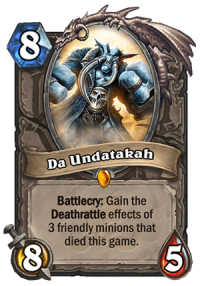
While Undatakah Druid is a new archetype in Rastakahn’s Rumble, it’s technically very similar to The Witchwood / Boomsday decks we already know – Taunt Druid and Big Druid. It shares a very similar win condition, just with an interesting twist. While it still wants to kill of Hadronox to get all of the Taunts back, it now has an “infinite” win condition with Da Undatakah shuffling himself in over and over again thanks to the Astral Tiger‘s Deathrattle. The deck runs most of the powerful Druid stuff, as well as a great late game sort of infinite win condition.
Since it’s a new archetype, it’s hard to say whether it will be a better version of Taunt Druid in the end, the decks will co-exist or maybe Taunt Druid will just turn out to be better. But for now, Undatakah Druid is a quite powerful ladder deck, with a few pros already hitting high Legend ranks with it (including Dog’s #1).
Undatakah Druid Deck List
- 0Undatakah Druid Deck List Guide – Rastakhan’s Rumble – December 20181
- 0Undatakah Druid Deck List Guide – Rastakhan’s Rumble – December 20181
- 0Undatakah Druid Deck List Guide – Rastakhan’s Rumble – December 20181
- 0Undatakah Druid Deck List Guide – Rastakhan’s Rumble – December 20182
- 0Undatakah Druid Deck List Guide – Rastakhan’s Rumble – December 20182
- 0Undatakah Druid Deck List Guide – Rastakhan’s Rumble – December 20182
- 0Undatakah Druid Deck List Guide – Rastakhan’s Rumble – December 20182
- 0Undatakah Druid Deck List Guide – Rastakhan’s Rumble – December 20182
- 0Undatakah Druid Deck List Guide – Rastakhan’s Rumble – December 20182
- 1Naturalize2

- 3Ferocious Howl2

- 3Savage Roar1

- 4Astral Tiger1

- 4Branching Paths2

- 4Ironwood Golem2

Undatakah Druid Mulligan Guide
VS Fast Decks
Higher Priority (Keep every time)
- Lesser Jasper Spellstone – Early game removal, lets you survive long enough to get to the mid/late game vs Aggro.
- Wild Growth – Your basic ramp card, you always keep it no matter what – being ahead in mana is exactly what you want in every matchup.
- Oaken Summons – Amazing T4 play, it puts some board presence (you hope to roll an Ironwood Golem vs Aggro), thins your deck and gives you Armor (upgrading Spellstone).
Lower Priority (Keep only if certain conditions are met)
- Ferocious Howl – Keep with Spellstone, so you have a way to upgrade it. 2 damage is nice, but it doesn’t clear 3-4 health minions, which can be quite important.
- Swipe – Against Paladin. You absolutely need it vs Odd Paladin, or else they wreck you with an on-curve Level Up!
- Nourish – Always keep with Wild Growth, without Wild Growth it depends on the quality of your hand. If it’s solid, then you keep it, if it’s bad, then you mulligan it and hope to get something better.
- Spreading Plague – Against Paladin – it’s often a single card win condition against a board full of small minions.
VS Slow Decks
Higher Priority (Keep every time)
- Wild Growth – Just like against Aggro, it’s your best keep – you want your ramp.
- Oaken Summons – While not as necessary as vs Aggro, you still prefer to have some board presence, and thinning your deck is not bad.
- Nourish – Unlike against Aggro, Nourish is a 100% keep vs slower decks. Depending on what you draw on your way, you either use it to draw 3 cards or to ramp up to your higher mana plays.
- Master Oakheart – It might be a weird keep, given that it’s a 9 mana card, I know. But it can absolutely win you the game if played on curve (which is usually 2-3 turns earlier than you should play it anyway), putting 3 strong bodies on the board.
Lower Priority (Keep only if certain conditions are met)
- Naturalize – If you know that you face a slower Warlock deck, such as Control Warlock, Cube Warlock or Even Warlock.
Undatakah Druid General Strategy
Vs Aggro
When you play against Aggro with a slower deck, your main game plan is always to survive. This time it’s no different. You don’t even need to go for your combos or anything, you pretty much win the game as long as you survive.
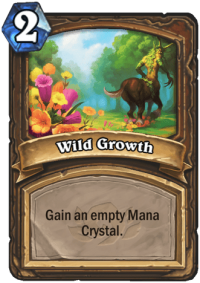
First of all – ramping is the most important thing. Don’t sweat about taking some damage in the early game, that’s basically a given – you make your comebacks in the mid game. Of course, if your opponent drops a high value target (like Flametongue Totem), then you try to kill at as quickly as you can. But normally, if you can choose between ramping up and clearing a minion, you generally go for the ramp. That’s because your curve is really high and you want to get to high mana as quickly as you can.
Since your goal is to survive, and this deck plays a lot of Taunts, your Aggro matchups are at least decent. Odd Paladin is in your favor, while the others are close to 50/50. Faster games are actually very straightforward – you usually start with ramp (and if not, you struggle and try to remove as much stuff as you can with the mix of Hero Power and early removals), then you most likely play the best thing you can on curve. Ideally, you wan to drop Malfurion the Pestilent or Amani War Bear on T7, Mosh'ogg Enforcer or The Lich King on T8 and Master Oakheart on T9, but
Nourish is an interesting case. Most of the Druid decks want to ramp with it, since they play Ultimate Infestation, so refilling after a ramp is not a problem. This deck, however, doesn’t run it, so you might struggle with card draw if you just ramp with it. There’s no reason to ramp up if you have no high mana cost plays in your hand. So use it to ramp when you actually have something to ramp into, otherwise go for the draw.
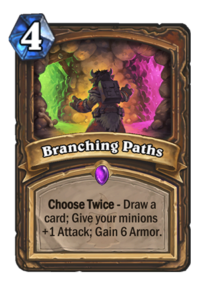
Don’t be too greedy with Branching Paths. Gaining 12 Armor is A LOT and it can save your skin a lot of time, buying you a turn or two. If you play it on the curve, when you’re still at high health, it might be tempting to always draw, but I wouldn’t do it. Draw only if your hand is really bad, if you have no plays for T5/T6, then you want to look for those desperately. If you have a decent hand, however, you should nearly always go for Armor. Armor is also useful when you’re holding onto a Lesser Jasper Spellstone. 6 damage for 1 mana is a great tempo play and might save you from having to use Naturalize to clear something.
Talking about Naturalize, it is an interesting case. Generally, it often gives your opponent much more power in the long run than it takes out of the board, but it’s also a high tempo play. If you face a threat you can’t kill right now, Naturalizing it is a good idea, because while in the long run your opponent will drop more of those, you save yourself a lot of life. And the thing is that giving them resources might not matter if you stabilize the board with Taunts anyway. Unlike vs Control, you don’t really need to save it for Hadronox, although if you’re getting closer to Turn 10 and you already had some Taunts dying, then it might be wise to do it. Reviving multiple Taunts is usually the best way to run away with the game completely.
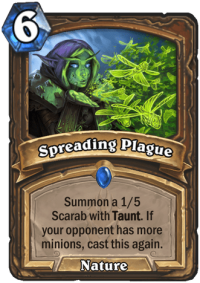
One way to win the game might be reversing the game with a big Spreading Plague. Plague alone is great against small minions / tokens, like 1/1’s from Odd Paladin, but if your opponent has some bigger minions, Plague + Branching Paths is a great combo. You can put a board full of 3/5 Taunts, which will most likely have way better trades against whatever your opponent might have. And the best thing about that kind of play is that since they are Taunts, you can often ignore whatever your opponent has on the board and go for their face. With four 3/5’s on the board, you can deal 12 damage immediately. Adding Savage Roar to the mix is 10 extra damage – that’s often enough to kill an opponent who has taken some damage already (e.g. Zoo from Hero Power, Odd Rogue from hitting minions with weapon).
But if you’re already in the late game and your opponent still isn’t giving up, Hadronox will most likely force him to do just that. Reviving a bunch of Taunts is most likely enough to seal the game completely. If your opponent has already blew a Silence (let’s say on one of your Taunts), then it should be relatively safe to just drop it on the board. It’s recommended to keep up with the meta to see which decks play Silence and how many copies. For example, most of the Odd Paladin builds don’t play a single Silence, so just dropping Hadronox on Turn 9 if you aren’t under a lot of pressure should be good enough. Technically, if Hadronox is still not enough, you still have your Undatakah combo, but that’s rarely necessary. After playing many games with this deck, I never needed Undatakah vs Aggro yet.
Vs Control
Games versus slow decks are significantly more difficult than those vs Aggro (strategy-wise, that is), because there are a lot more things you need to consider. Early and mid game is still very straightforward. You don’t really have many plays to make anyway. Ideally, you wan to draw your Ramp. You might need to use your removals on some of their early game minions (it’s not like they’re very threatening, but it’s better to not take any unnecessary damage). In rare cases, like facing Even / Cube Warlock, you might need to Naturalize something in the early game, but most of the time you want to save those.
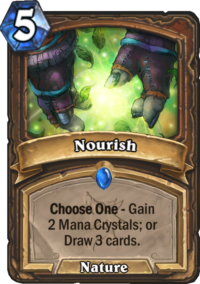
The first two decisions that might be important come down on Turn 4 and Turn 5 with Branching Paths and Nourish. Unlike against Aggro, gaining Armor with Branching Paths is not necessarily the best idea. Since you don’t play UI, your card draw is limited, so you’d rather draw with your Branching Paths. Don’t draw only if your hand is already great. Then, there’s Nourish. This is against a difficult decision – normally you’d nearly always go for the ramp, but in this case, you might not do that. You ALWAYS ramp if you have one of your high mana plays, especially The Lich King or Master Oakheart. Those two can carry the game if dropped early. Alternatively, you can go for Ramp if you have a second Nourish or Branching Paths so you can draw. DO NOT ramp into nothing, that’s a pretty common mistake – ramping and then not utilizing the mana in any meaningful way.
The easiest way to win the game is probably Master Oakheart. While it’s not as powerful as the one in regular Taunt / Big Druid (Dragonhatcher versions), it still puts a 5/5, 2/14 and either Astral Tiger, Ironwood Golem or Hadronox itself. That’s 10 damage, which doesn’t die to a single target removal, or to the regular AoEs, your opponent most likely needs a board wipe to get rid of those. And if he doesn’t, you can even buff them with Branching Paths – that’s 16 damage that’s very hard to get rid of now. Of course, pulling out Hadronox might be a double-edged sword, but if you will keep your opponent busy Silencing/transforming it instead of getting rid of the board, he can just die.
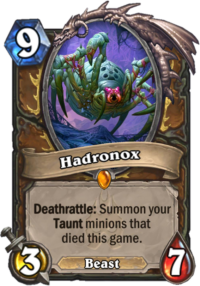
Unlike Aggro, however, you will rarely win by simply surviving (it MIGHT be the case vs some combo decks, but most often you need to take initiative). Your main win condition in slower matchups is Hadronox and then later Da Undatakah. The combo is actually quite simple. You first play a bunch of Taunts, then drop Hadronox + Naturalize (that’s why you want to save it if possible), reviving those. That might actually be enough to win if your opponent has no big board clear, but most of the time they do. Now, assuming your Astral Tiger also died, you can now drop Da Undatakah, which will take the Deathrattles of both Tiger and Hadronox, which means that when it dies, it will BOTH summon a board of Taunts and get shuffled to the deck. But Undatakah is still vulnerable to Silence / Transform effects, that’s why you ideally want to kill it immediately. You can do it with Naturalize or upgraded Spellstone. But wait, there’s more!
Ideally, before dropping your Undatakah, you want your Astral Tiger to die TWICE. It means that Undatakah will take both of those Deathrattles as well as the one from Hadronox, meaning that when it dies, it will revive Taunts and get shuffled TWICE. That’s important, since it’s your way to play around Silence and Transform effects. For example, you drop your Undatakah, kill it off, then you have two in your deck. You play another one and kill it off immediately again – you have 3 in your deck. Now your opponent needs THREE instances of Silence/Transform to deal with them, which is kind of rare – the only deck that runs so many is Shudderwock Shaman with 2x Hex and Earth Shock, but most of the decks simply won’t have a way to deal with it so many times. And then you go infinite – you keep shuffling your Undatakahs and reviving Taunt minions. The only way to realistically lose at this point is for your opponent to combo you down, since Fatigue is also not a problem.
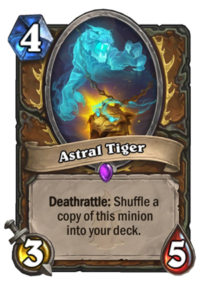
However, while we’re at the combo… playing Astral Tiger TWICE is great, but Undatakah will only take up to 3 random Deathrattles. So after it died for the second time, you don’t want to play it again. Adding another Deathrattle to the pool will mean that Undatakah will have a chance to get 3x Shuffle with no Hadronox, and that’s not something you want. 2x Shuffle + 1x Hadronox is the optimal route.
What about Spreading Plague? The card messes up with Hadronox a bit. Of course you’d rather revive The Lich King, Mosh'ogg Enforcer, Amani War Bear or even Ironwood Golem than a 1/5 Taunt. So you sometimes end up with a difficult choice – do you play the Plague or do you treat it as a dead card in slower matchups? It’s a though decision, but most of the time you should just play it if you need it. Let’s say that your opponent is putting a lot of pressure and you soon will be dying – then you 100% play the Plague, because it’s better to dilute your pool of good Taunts with 1/5’s than to just die and lose the game. You can also consider going for it if you have a chance for a counter-lethal. For example, if you’re holding onto Branching Paths + Savage Roar and you get a good 4-5 minions Plague that won’t likely get cleared, then you can go for it and try to set up lethal. And in the end, if you set up your infinite combo, it doesn’t REALLY matter what minions you’re reviving – even if half of the minions you get back are 1/5’s, then that’s okay, because you still get basically infinite value.
There’s also Malfurion the Pestilent. An amazing card, works very well in slow matchups, because it lets you either survive until you start doing your combos or start putting pressure earlier. It can also summon 1/5 Taunts, but in this case, you can actually go for 1/2 Poisonous instead. Unless you really need those Taunts, that’s most likely what you should be doing – most of the time, 1/2’s with Poisonous are good enough and they don’t mess up with your revive pool later.
Undatakah Druid Card Replacements
Undatakah Druid is a high Dust cost deck. Most of the builds are in the 9-12k Dust range, and while there are key Legendaries that you can’t replace, there are some cards that you might remove from a budget version without hurting your win rate that much. But always keep in mind that the more Legendaries/Epics you replace with more budget options, the worse this deck becomes.
- Malfurion the Pestilent – It’s an amazing card, it was played in basically every Druid deck ever since it was released. That said, if you don’t have it yet for some reason, I wouldn’t craft it right now, since it rotates out very soon. It’s a solid card that improves pretty much every matchup, but it’s not a key card in this build. There are a lot of “generic” replacements, such as Wrath, Tar Creeper or Trogg Gloomeater.
- Da Undatakah – You PROBABLY do want to play Undatakah in a deck called “Undatakah Druid”.
- The Lich King – The Lich King is the best late game Taunt option and while it’s not absolutely necessary, I don’t think that I would play the deck without it. Still, if you want to try, you want to replace it with another big Taunt, such as Amani War Bear or Primordial Drake.
- Hadronox – Hadronox is a key card in your Taunt reviving strategy, you absolutely need it.
- Master Oakheart – A great Legendary in a deck like that, ramping and dropping Oakheart on 9 (which is often as early as 6 for your opponent) can win the game immediately. But technically, he’s not irreplaceable, since he’s not necessary for your basic strategy. Another big minion like Amani War Bear or Primordial Drake are probably the best replacements.
- Astral Tiger – Necessary in the Undatakah strategy, thanks to Astral Tiger you can shuffle it back again and again.
- Branching Paths – Playing Druid deck without Branching Paths is a bit awkward, the card is just so good. It’s Armor when you need it, card draw when you need it and a huge win condition with +2 Attack after you flood the board with either Spreading Plague or Hadronox. If you’re missing one, I’d replace it with Ultimate Infestation or Juicy Psychmelon (ideally, but both are Epics), or a more generic replacement such as Wrath, Tar Creeper or Trogg Gloomeater. But if you’re missing both, I’d say that you need to craft at least one, or just play something else.
Leave a Reply
You must be logged in to post a comment.





I hate so much Blizzard and his team of Hearthstone developers for destroying this archetype with these tadpole nerfs… RIP the only deck that i liked to play in Rastakhan. Now the Hunter has 3 Tier 1 decks, what a beautiful diversity!
After the nerfs happened, 1) is the deck still viable? 2) is it actually possible to add Keleseth as they are no other 2-drops now?
Oh sorry, Keleseth can’t be played due to Oaken Summons. My bad.
I’ve been playing this deck for like 2 weeks and I was having a ton of fun with it! Now I’m wondering if it’s still viable or not. It’s playable, but it’s a lot slower. Haven’t played it enough yet to notice it affect my average win rate.
Should you replace the Wild Growth & Nourish and if yes, what would you replace them with?
My first thoughts for replacement options would be:
– Zilliax
– Biology Project (although I don’t like the idea of giving my opponent free ramp)
– Innervate (1 or 2) (for instance to innervate + nourish 2 mana crystals on turn 5 if you have Malf, Oakheart, Lich king in hand)
– Juicy Psychmelon
– Perhaps some 1-attack minion to synergize with Oakheart & Oaken Summons (Crypt Lord or Tar Creeper perhaps?)
Would love to hear some thoughts!
Also my 2 cents on Juicy Psychmelon: there is already a good amount of card drawing in this deck, and with the Lick King the risk of having a full hand is high.
I am testing the Tortollan Forager, with funny outcome, e.g. it created a couple of legendaries, or huge taunts.
I’m currently trying it with Zilliax and 1 Innervate instead of 2 Wild Growth. I’ve kept the 2x Nourish. Been doing okay so far.
I’m not sure about the Forager. It’s a battlecry minion so it seems like a waste of a card if you accidentally pull it with Oaken Summons or Oakheart, doesn’t it?
Yeah, I was about to write the same, it’s a waste if you pull it accidentally, and happened to me a couple of times. Definitely a no-go.
Anyway this deck started to be quite a bit less powerful after the ramp nerf.
I am still playing it and it’s still doing well (rank 11, not that high I know), although not as good as it used to be with Wild Growth on Turn 2, Oaken Summons on Turn 4, and Nourish on Turn 5. Strong board presence, 6 armor and 8 mana by turn 6.
Now Wild Growth becomes playable late in the game. Turn 3 and above this deck is already dealing with minions and aggro, so wasting one turn playing WG does not make much sense IMHO.
Sure the deck has lost some of its potential, which was great.
No, isn’t. RIP Taunt Druid after the girino’s nerfs.
damn this deck is sooo fun, couldnt even finish one game, everytime they surrender
100% worth crafting!!
My 2 cents about the deck.
In october I got to legend in less than 40 games playing only the old hadronox druid. The only hard problems are hex and polymorph. This deck isn’t as vunerable to them as much but they do pack a punch. Also this deck suffers hard from an early geist. Also Im not sure about the whole Oakheart package. The 2-14 with divine shield is great but assuming you get unlucky Oakheart might pull a lonely tiger or a 3/6 taunt… and while in best-case-cenario it works great I just dont feel it as powerfull as the drake package. Im figuring the deck out with Juicy Pscyhmelon instead of Oakheart and Stampeding roar to get the hadronox out early just for those extra rush cases and nasty geists but you dont want to draw on 4 vs aggro. I also tried 1/5 taunt with posionous in the Oakheart version… well both feel subpar. Juicy seems fine if you get the dream nourish in openning hand but who would keep psychmelon in the oppening hand vs all those aggro players.
What I did love about the deck is the inclusion of Malfurion, also the astral tiger does seem to make oaken summons better late game cause everyone who’s played hadronox knows the bad feeling when you draw them gollems before it. I questioned the savage roar but rare cases when you kill Undatakah do leave you with 1/5’s alot and savage helps ALOT.
Long Story short: I love this new deck. Hate how Geist ruins it, not sure Oakheart is the slot for 9.
This deck is a force to be reckoned with. Built it 100% as described. Was uncertain about having only one Deathrattle for the Da Undatakah to play off of, but wow… Staggering how powerful this deck can be. I’m still thinking it’d be nice to incorporate some other Deathrattle minor for him to feed off of but honestly don’t know what I’d recommend. The deck seems pretty smooth as is.
I didn’t notice, Hadronox of course has a deathrattle that’ll trigger as well! I retract my previous concerns.
Oakheart is such a powerful card in this deck, but he doesn’t worth 1600 dust so close to the rotation.
That and Undetakah are basically all I’m missing in this deck, but I’m willing to craft the latter.
What would you say I play in place of Oakheart? Should I leave the Enforcers in with no way to cheat them out of the deck?
A suggestion I have for this deck is running two Astral Tigers. Undatakah will adopt two of the same deathrattle and shuffle himself twice into your deck, and copies of undatakah after that will do that. In this way, you have a bottomless anti-fatigue deck.
In addition, two Astral tigers serves the purpose of making sure Undatakah adopts at least one of those deathrattles because I’ve had games where my Astral Tiger got hexed, and I ran out of steam immediately after killing my Undatakah.
I just tested this and I can confirm Undatakah adopts the deathrattle twice if both Astral Tigers die, and shuffles himself twice into your deck.
which card did you remove for the 2nd astral tiger?
It’s nice to get the astral deathrattle twice, but you need to be careful not to get it THREE times, cause then your Undatakah’s are just 8 mana 8/5, which are not that good.
I’m confused. How would Astral deathrattle triggering 3 times be a bad thing for Undatakah? My understanding is if Astral has been triggered 3 times, Undatakah would then shuffle 3 copies of himself into the deck. Am I missing something?
You’re right, but then it would not revive any Taunts 🙂 You prefer full board flood + 2 shuffles than just 3 shuffled by a LOT.
Wow… I didn’t even register Hadronox. Crazy combo.
When you are playing this deck, Astral Tiger is easily played twice per game. You just have so many ways to draw it.
Also, most games rarely get to the point where you need a third Undatakah.
Because of this I wouldn’t recommend running 2 Astral Tigers.
Downside to running one Tiger is that I’ve had my tiger get hexed or silenced or sheeped and then my combo fails and I don’t get my infinite Undatakah.
It’s actually possible with just one. It just has to die, then you have to play it again and it has to die again. It happens commonly in a longer game, especially thanks to the Oaken Summons.